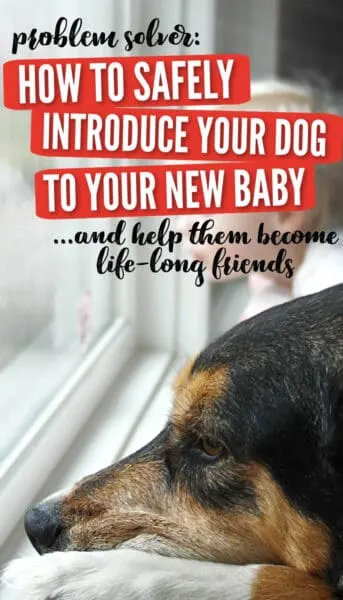Updated August 5, 2022
Bringing home a new baby is an exciting time.
For many first-time parents, arriving home will often figure out how to introduce their dog to a new baby.
When I brought my son home as a newborn, I brought him into a house with 2 large german shepherds, 2 large rottweilers, and a 4-pound Maltese.
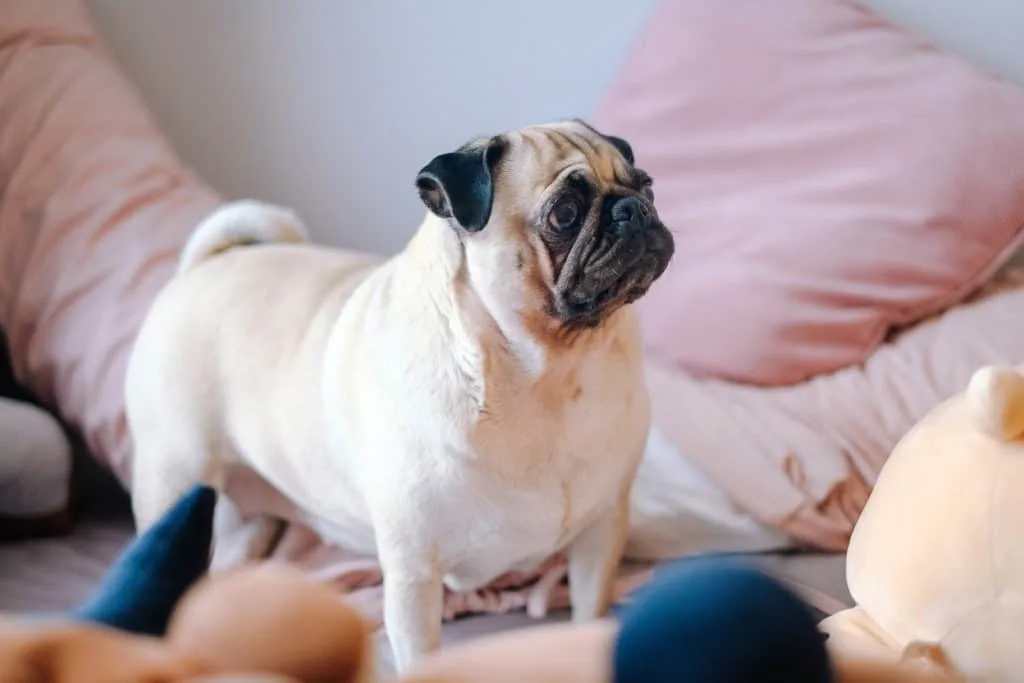
I also had a kennel with outside dogs and a litter of puppies a few times a year.
At the time I had my son, I was showing and breeding dogs, so keeping him safe around the dogs was my #1 priority.
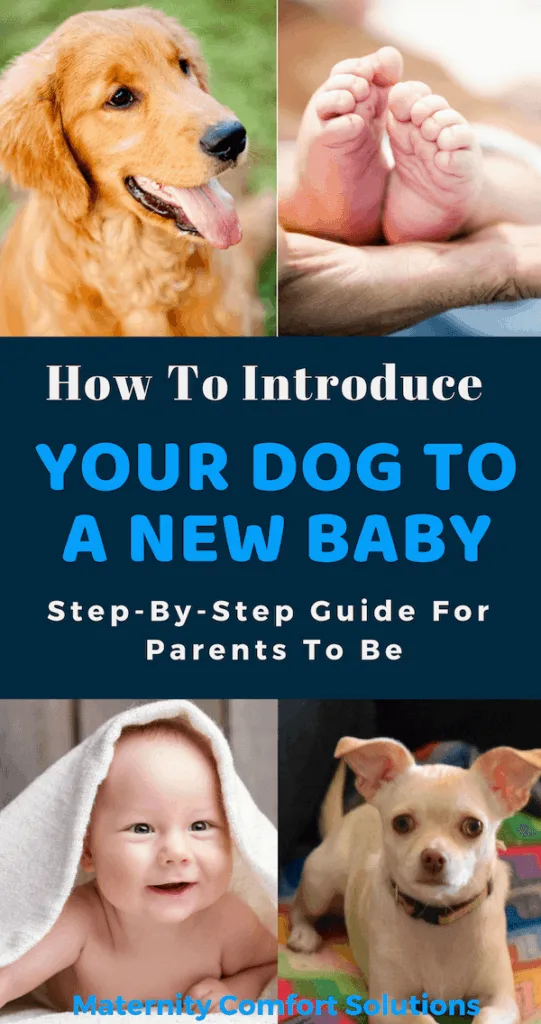
Babies and dogs can become lifelong best friends and packmates.
However, introducing your dog to a new baby requires prepping your pet ahead of time.
You want to make sure the first “meet and greet” between dog and baby is done in a slow, calm, and controlled way.
Roughly 44% of all family households in the United States have a dog (American Pet Products Association, 2015-2016) and according to the Centers for Disease Control, there are 4.7 million dog bites in the United States each year.
The majority of dog bites in children are done by a dog they know, often their own.
So preparation is key to ensuring your new baby is safe around your family dog.
How to prep your pet before the new baby arrives:
1. Obedience training is a must.
The first and most important tip we can give you when introducing your family dog to a new baby is to make sure your dog is obedience trained.
Obedience training gives you control over your dog and lets your dog know you are the pack leader and you make the rules.
Early in your pregnancy consider taking your dog to an obedience class or a refresher class if you have been to one before.
If you have not crate-trained your dog, now is the time to begin.
Your dog’s crate becomes their safe place and a safe place you can put them if you need to keep them away from the baby for a time.
Basic skills to teach your dog:
- Sit: means to sit
- Down: means to lie down
- Stay means to stay in sit, down, or place until called
- Place: Go to your dog bed, lie down, and stay.
- Back-up: means to back up away from you.
- Leave it and Drop it: means to leave an item that falls on the floor alone, drop it means to let go of an item the dog has picked up immediately.
- Kennel up: Go in your crate and lie down.
- Wait: Sit at the door both entering and exiting and wait before going out or coming in.
- Bark: Bark on command, be quiet unless given the command.
These are the basic skills we have taught our current four dogs and the basic skills I taught my 5 house dogs when I brought my first son home years ago.
You may have other requirements so it is best to talk to a professional trainer about your dog and your specific training needs.
2. Play baby sounds before your baby arrives home.
When introducing your dog to a new baby, help your dog get accustomed to the sounds of a newborn baby.
You can get a doll that cries and moves, you can play youtube videos of babies crying, talking, and laughing.
Another great option is to buy the mp3 or CD of Baby Sounds For Pets on Amazon or if you have Amazon Prime it is included for free in your membership.
You’ll want to work with your trainer on what you want your dog to do when they hear the baby cry.
Some dogs have a high prey drive and loud noises can really set them off.
So training them to go to “place” or to “sit and stay” are skills you’ll want them to associate with the baby crying or yelling.
3. Gradually start to change your daily routine with your dog.
Dogs thrive on routine. So changes to your or their routine can trigger anxiety and behavioral issues.
Once your baby arrives home, your life will be anything but routine and you don’t want your dog to associate any change with the new baby.
It is important to gradually begin to make changes to your routine and practice those changes with your dog.
If your dog sleeps in your bed, but you plan to have the dog sleep elsewhere, practice that change before the baby arrives.
Change the times you feed and walk your dog, life with a baby can be unpredictable.
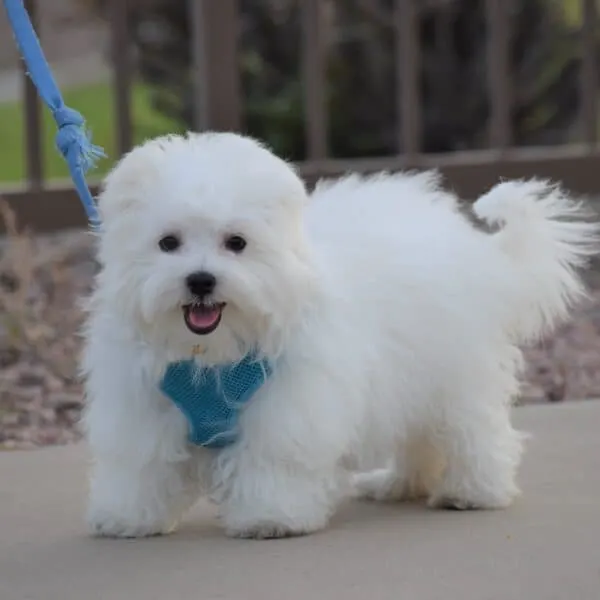
Cayman the Morkie out for his nightly walk
My dogs would often get excited around feeding time, barking, and running back and forth in the kennel and that would get the house dogs going.
Barking dogs and a sleeping newborn didn’t mix.
So I changed up feeding times and taught my dogs that they did not eat until they were quiet and sitting in their runs, same for my house dogs.
Maybe your dog gets excited around play and mealtimes, if they bark a lot, you may want to teach them to be quiet and wait for you to feed them so they don’t wake up your sleeping baby.
Training can take time and patience to teach so it is best to do it before your baby arrives.
Here is a great article on the process: How To Keep Your Dog Calm During Mealtime.
4. Introduce your dog to baby gear you plan to use.
Place various baby items around the home.
You can use a changing table, stroller, baby swing, and a rocking chair.
Get your dog used to the sight, sounds, and smells of your baby gear.
Teach your dog how to behave around the baby gear.
Teach your dog to lie down quietly next to the rocking chair or to stay away from the baby swing.
5. Set space boundaries with your pet.
Once your baby arrives home, keep your dog at a distance from the baby, while introducing the smells, sounds, and sights of your baby.
Make the nursery off-limits to your pet.
It is important to establish that the nursery and baby belong to you and as the pack leader you decide when your dog can enter the room and interact with the baby.
6. Get a Baby gate.
This lets your dog know what is off-limits.
Depending on the layout of your home, a gate to the nursery is a must.
There are many types of gates to choose from depending on the dimensions of the entryway and the size of your dog.
Extra Tall Walk-Thru Gate, Bronze
7. Change how much attention you give to your dog.
The new baby is going to consume lots of your time and family and friends will be in and out lavishing attention on the new baby.
You do not want your dog to be upset or jealous of the attention the new baby is getting.
So about a month before the baby is born, begin decreasing the amount of one-on-one attention you give your pet and change the timing of play sessions.
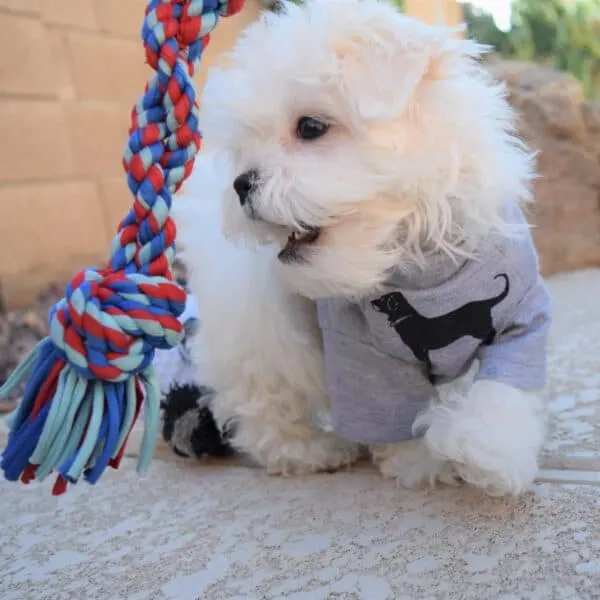
Cayman the Morkie, playing with his rope toy.
Dogs are creatures of habit and it doesn’t take long for your dog to come to expect attention from you every day at a certain time.
If you play ball every day after your pet eats at 5:00 change the playtime to 6 or 7:00.
8. Have a place in the house that is strictly for your dog and is off-limits to your child.
It can be as simple as a corner of a room with a dog bed.
Animals need a place they can call their own when they are stressed.
This is not about territorial behavior but simply a place your dog knows is always there.
It could be their dog crate in a separate room or a raised dog bed. Just something so they have a safe space they can go and get away from the baby if they want to.
Dogs need their space. They need a safe place to be able to retreat to when they have had enough.
How To Introduce Your Dog To A New Baby:
Having a plan for how you’ll introduce your family dog to your baby is important.
The safety of your baby is a priority.
Dogs feel our energy and it is important that when you arrive home you greet the dog in a happy and calm state.
If you are nervous, the dog will be nervous.
If your dog has been crated or cooped up in the house for a few days, it is a good idea to take your dog out for a walk and play session to burn off excess energy and help your dog calm down.
[content-egg module=Amazon template=grid next=3 hide=price cols=3]
1. Give your dog a few days to get used to the sight, smell, and sound of a real baby from a safe distance.
You want to be calm and relaxed too. If you are a first-time mom, you may be nervous about caring for your newborn for the first few days after discharge.
That is normal to feel that way, but your dog just senses the nervous energy in the house.
It might be better to hold off on up-close introductions for a few days, so you and your dog have time to adjust to the new family member.
2. After a few days, using a leash, slowly introduce your dog to the baby.
Don’t force your dog to interact. Let the interaction occur naturally. When introducing a dog to a new baby, they can easily become nervous or frightened.
Speak calmly and happily to your dog and have your helper offer treats and praise.
Encourage your dog to sit close by and praise when your dog settles down and is calm.
If your dog is calm and you feel comfortable you can allow your dog to sniff the baby. This must be done with your dog on a leash at all times.
Try to keep these interactions short at first. You want them to be positive experiences for your dog.
Gradually increase the amount of time you allow the dog to be around the baby (Always, always supervised).
3. When your dog has become used to your baby on the leash, remove the leash and let your dog explore carefully.
Always position yourself between your baby and your dog.
Your baby may make startling sounds and you want to be sure this does not trigger your dog’s prey drive.
If your dog is off-leash, tell the dog to sit or lie down near you and the baby.
Before you let your dog off-leash around your baby, be sure your dog is well trained and responds to your verbal commands.
Be honest with yourself about how much control you have over your dog.
If your dog shows any signs of aggression towards the baby or fails to listen to your commands you need to call in a professional trainer to help you manage the situation.
4. Make sure to give your dog a lot of attention when the baby is present.
If you only give attention to your dog when your baby is eating or sleeping, dogs can associate only getting attention when the baby is not around.
You don’t want that. You want your dog to associate good things with the presence of the baby.
What I did was put my dogs on a down-stay in the same room I was feeding the baby or holding the baby and I would give the dogs a chew toy or some treats and have the experience be a happy, calm, positive one.
This also helps them learn that the baby is a pack leader. Teaching your dog to respect the baby is very important.
5. Do not leave your family dog alone with your baby.
Under no circumstances do you ever want to leave your baby or small child alone with your dog.
The reason children are injured by family pets is not necessarily because the family members are not cautious.
It can simply be because the family pet was startled while sleeping or was eating.
Over eighty percent of dog bites involving children occur when a child is left unsupervised with a dog. (Source.)
When your child becomes mobile:
Don’t allow your baby or child to pull on your dog’s ears or tail or engage in any other behavior that is going to upset your dog.
When this happens, it is not uncommon for dogs to nip as this is an instinctive response.
Unfortunately, a child’s hand or face can be injured or scarred in the process and it can happen very fast.
Why do dogs bite?
Dogs can bite for a variety of reasons the most common are:
- Being fearful or feeling threatened
- Being in pain
- Trying to protect food, toys, space
- Being a dominant and aggressive dog and not being well socialized and trained
- Female dogs protecting their puppies
- A young dog that is “mouthy”, “nippy” or “play biting”
Do some dog breeds bite more?
Dog bite fatalities are rare. However, they do happen.
The breed and size of the dog aren’t a good predictor of dog bite potential.
Small size dogs bite with just as much frequency as large dogs.
We have several dogs, big and small.
We have two rescue Chihuahuas, a Morkie, and a German shepherd.
I would not leave any of them alone with small children and they are raised with them.
I would feel no different if I owned a Golden retriever.
Bites can happen very quickly and in a young child that is on the same level as the dog, that bite is more likely to be to the face.
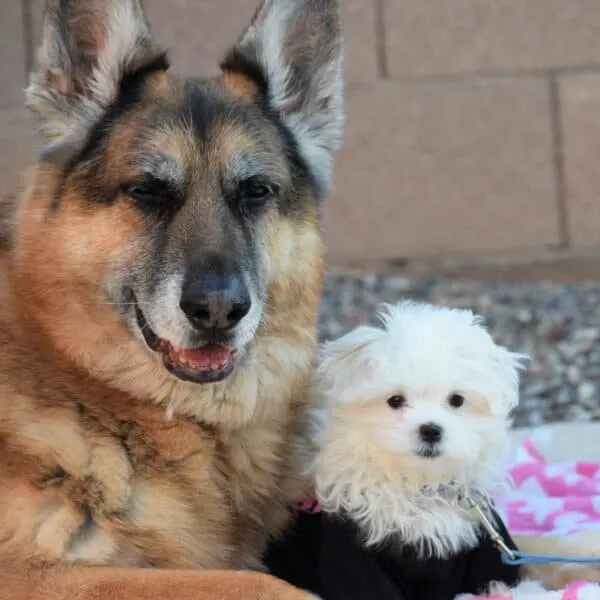
Our German shepherd and Morkie
Final Thoughts
Earlier we said breed and size of the dog is not a good predictor of bite potential, that is a general rule to keep in mind.
But 66% of all fatal dog attacks between 2005-2017 were committed by the American Pit Bull Terrier. (Source)
A stat to keep in mind but not a condemnation of the breed on the whole. Any dog has the potential to bite.
If you have multiple dogs, you will want to introduce each dog to a new baby one at a time.
Having a baby is an exciting and often stressful event, especially for first-time parents.
Don’t let concerns about introducing the family dog to your baby add to your stress.
If you introduce your family dog to a new baby the right way they can become lifelong friends.
Take the time to prepare your dog before and after the baby’s arrival with proper obedience training, planning, and supervision.
What to read next:



